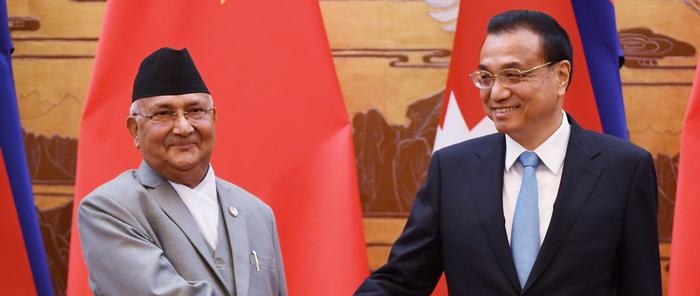China and Nepal to build rail link
June 26, 2018 | Expert Insights

China and Nepal have agreed to build a railway connecting the Tibetan city of Xigaze with the capital of Nepal, Kathmandu, according to reports.
The deal with Nepal comes amid growing Chinese investment in the Himalayan country.
Background
A landlocked country in the Himalayas, Nepal shares a border with both India and China. An ancient culture, the nation was closed off from the rest of the world till 1950. Before that, the Shah Dynasty had established the Kingdom of Nepal. It also formed an alliance with the British Empire, under its Rana dynasty of premiers. After it ended its isolation with the outside world, Nepal instituted Parliamentary democracy in 1951. In 2008, the Hindu monarchy came to an end after the Nepalese Civil War. Thus, it became a Republic. At the time, it was the oldest Hindu monarchy in the world.
Ties between Nepal and China began in the mid-7th century. Initially subdued, trade ties have grown significantly since 1975. Nepal remained neutral during the Sino-Indian border conflict of 1962. Since 2016, China has opened 32 border crossing points into Nepal. China has also made significant investments in improving infrastructure in Nepal. It was announced in January 2018, that China will become Nepal’s second internet service provider. Up until now, Nepal depended on India for internet access.
Nepal and China have a number of bilateral mechanisms in areas including economy and trade, agriculture, and border law. Chinese assistance to Nepal, which began in the 1980s, falls into three categories: Grants (aid gratis), interest free loans and concessional loans. Beijing is Nepal’s second largest trading partner. However, India continues to be Nepal’s key economic as well as security partner.
Ties between India and Nepal have traditionally been good. Diplomatic ties were established after the two nations signed the 1950 Indo-Nepal Treaty of Peace and Friendship. The two countries share close linguistic, marital, religious, and, cultural ties. The border between India and Nepal is an open boundary, people of the two nations come and go freely. However, ties between the two nations have strained since 2015. There have been reports of anti-Indian sentiment growing among the citizens as well as the government. The two countries also have unresolved border issues.
Analysis
China and Nepal have agreed to build a strategic railway link connecting Tibet with Kathmandu, which Nepalese Prime Minister K P Sharma Oli sees as an alternative trade route for supply of commodities to the landlocked Himalayan nation.
The agreement is one of the deals signed during a visit by Oli to Beijing, where he held talks with Chinese Premier Li Keqiang, among others. Chinese government officials stated that the two countries signed more than 10 agreements during the visit, covering the fields of technology, transport, infrastructure, and political cooperation.
Li stated that China also wanted to enhance "cross-Himalayan connectivity" with Nepal by improving links through aviation, trading ports, highways, and telecommunications. Oli expressed his country's support for China's Belt and Road initiative, a global trade infrastructure project that is opposed by India.
This is the second significant initiative by Oli, after he signed a transit trade treaty with China during his 2016 visit to reduce dependence on India for transportation of goods to Nepal. The new railway line will connect the Gyirong trading port in the city of Xigaze in Tibet with the Nepali capital Kathmandu, Vice-Foreign Minister Kong Xuanyou said.
China has been building rail, road, and air links in remote areas of Tibet spending billions of dollars. A railway line was launched in 2014, linking Tibet's provincial capital Lhasa with Xigaze. Xigaze, also known as Shigatse, is the closest Tibetan city to Nepal. Earlier, there were reports in the Chinese official media that the railway line was to be extended till India.
According to a joint statement issued by the two nations, "The two sides agreed to intensify implementation of the MoU on Cooperation under the Belt and Road Initiative (BRI) to enhance connectivity, encompassing such vital components as ports, roads, railways, aviation and communications within the overarching framework of trans-Himalayan Multi-Dimensional Connectivity Network".
The two countries agreed to make good use of the long-term communication mechanism on railway cooperation between government departments and promote railway cooperation. Nepal has agreed to intensify the implementation of MoU on China's BRI. India has expressed strong reservations over the BRI as the China-Pakistan Economic Corridor (CPEC) passing through the Pakistan-occupied Kashmir (PoK) is its flagship project.
New Delhi has been closely watching Beijing's growing presence in Nepal in recent years with concern and has promised its own infrastructure projects as a counterbalance. However, it has so far not matched Beijing's degree of investment in the small Himalayan nation.
Assessment
Our assessment is that India remains the main economic and security partner for Nepal. However, the image of India among Nepali citizens has been negatively affected in the recent years. The Indian government should be mindful that if China succeeds in replacing India as the key partner with regards to transportation, technology, and telecommunication, then it would have well created a fissure at the Himalayan border that separates the Indian mainland from China. We believe that India may have to work harder to strengthen positive ties with its smaller neighbors if it wishes to maintain its position as a regional power.








Comments